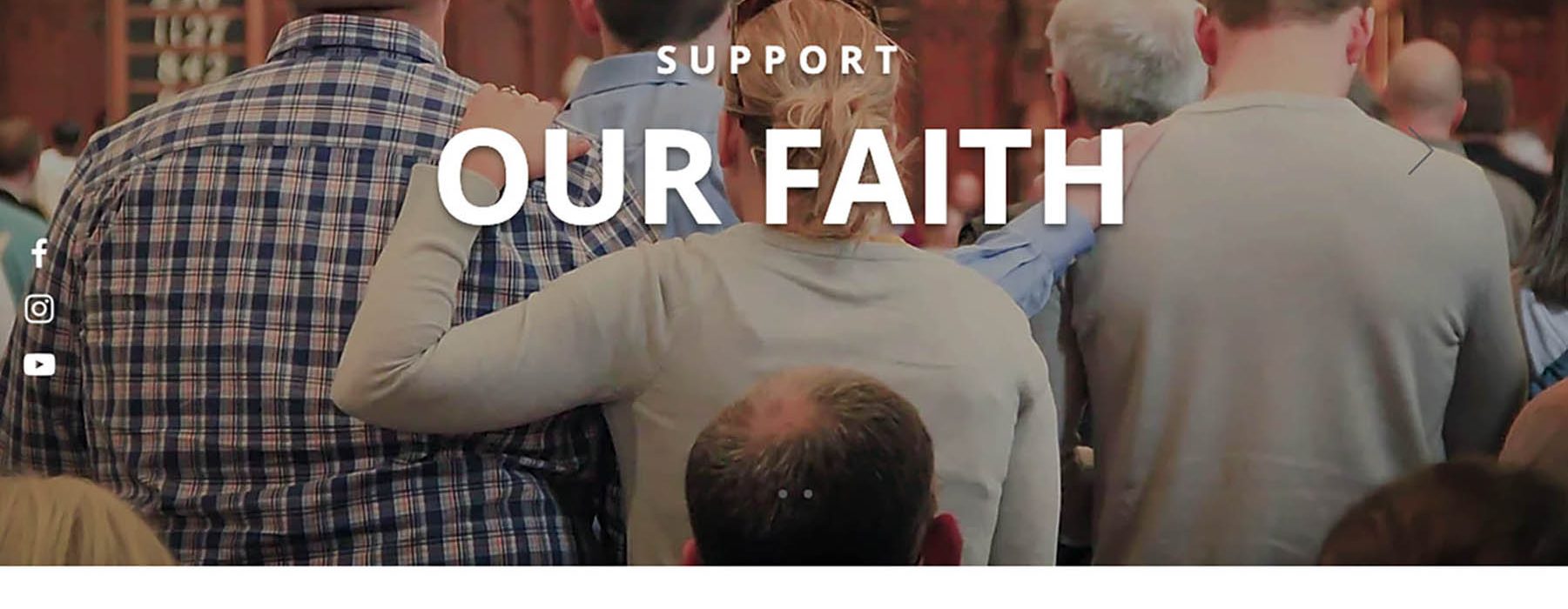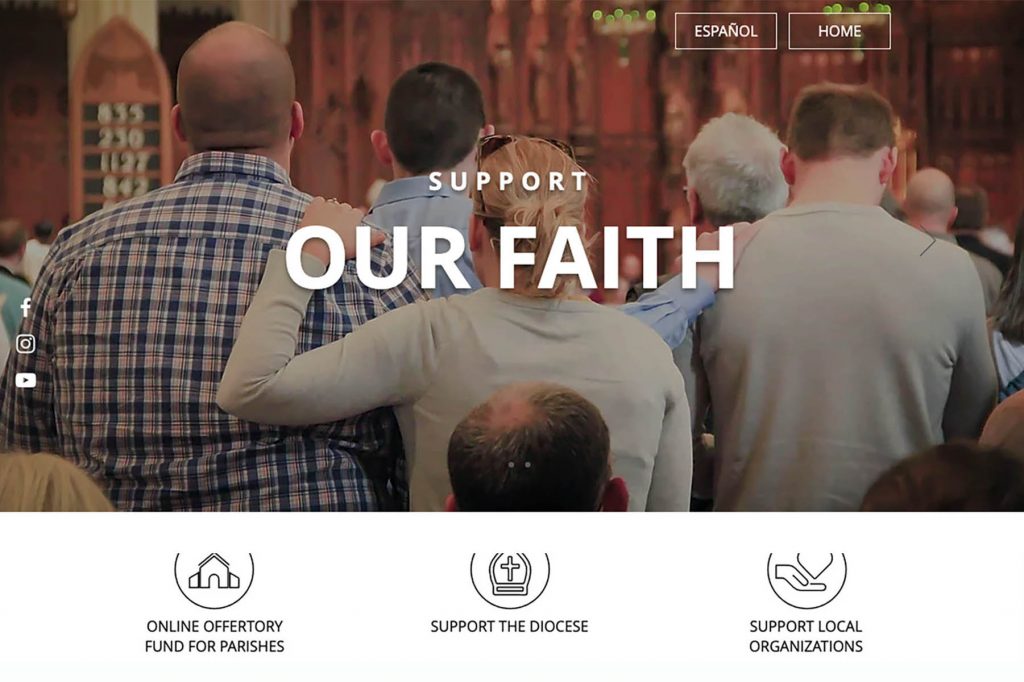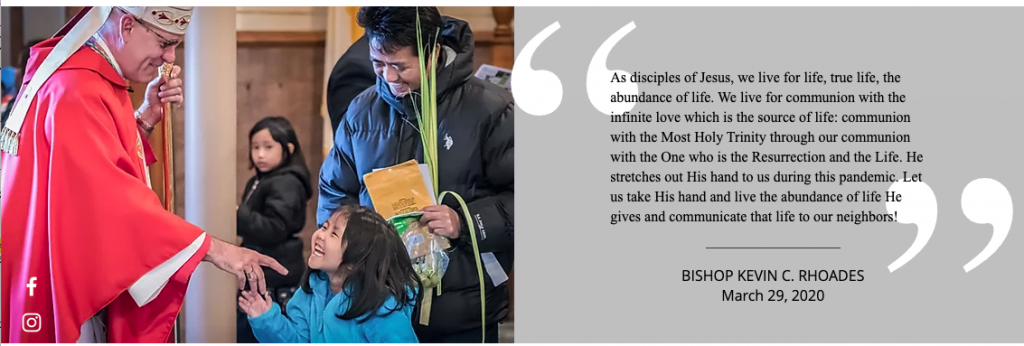April 29, 2020 // Diocese
Offertories, parish communication set off on new paths during COVID-19
As Catholics in the Diocese of Fort Wayne-South Bend enter a seventh week of suspension of public Masses, worshipping from living rooms and home offices is the new normal. Unfortunately, that’s where most collection envelopes have stayed as well.
Parish collections across the Diocese of Fort Wayne-South Bend are taking a significant hit. With no way to pass the collection basket, the weekly offertory — the main source of income for most parishes — faltered immediately. Meeting expenses became an immediate challenge.
For more details visit: www.diocesefwsb.org/give
The biggest expense challenge by far for parishes is personnel costs — parish and school staff salaries, wages and insurance, all of which still have had to be paid during the pandemic-related closures and stay-at-home orders. In the face of the compromised parish collections, parishes and schools have been forced to lay off personnel in many cases.
As a lifeline, some parishes have taken to reminding the faithful to give by mailing their donations into the parish, or by using what looks to be the post-COVID-19 choice of giving tools: online giving.
At St. Monica Parish, Mishawaka, 28% of regular givers submitted their donations this way. Through daily social media posts, the parish was been able to share with members that it is still working hard to bring people closer to the Lord and help them enter into the Triduum and Easter, however, and the effort made a difference.
Pastor Father Jacob Meyer said during the last few weeks, however, the percentage of families signed up for online giving increased 63%, to 98 families. “Most people sent in their envelopes as well as an extra offering for those in need as well as through online giving,” he noted. This generosity bolstered the parish’s ability to continue performing works of charity.
“Our social media presence has been the largest factor,” he said. “We’ve used this medium to help people know that we as a Church are here for people in need, parishioners or others in the community. As a result, our people have responded generously to help with the poor and I now have a fund to help those in need.”
Although Father Meyer had a Facebook presence prior to the pandemic, that presence is now more frequent and includes the livestreaming of Masses.
On April 6, the diocese stepped in to assist parishes interested going online for weekly and one-time donations. A new website was rolled out, diocesefwsb.org/give. Through the site — which is also navigable in Spanish — any individual may donate directly to any parish in the diocese by designating that parish from a drop-down list. They can also donate to the diocese itself, to the Annual Bishop’s Appeal, Pentecost Collection for the Education of Seminarians or the office of diocesan communications.
Local Catholic organizations like Catholic Charities, the Women’s Care Centers, the St. Vincent de Paul and Christ Child societies, and others can also be accessed through the site for the purpose of donating.
Both those who have previously made an online donation through the diocese and first-timers can donate through the site. The process is short and fairly simple, in the hope that someone who hasn’t given to their parish in such a way before might try it during this crisis, if they’re not inclined to mail a check.
Additional good news for parishes arrived March 27 in the form of a law signed by President Trump to provide relief for taxpayers affected financially by the pandemic. The Coronavirus Aid, Relief and Economic Security Act includes tax provisions for Americans who give to charitable organizations. According to the Business Office of the diocese, it includes an above-the-line deduction for nonitemizers of up to $300 for cash contributions to a public charity, including parishes. For individuals who itemize and certain corporations, the CARES Act temporarily increases limitations on deductions for charitable contributions made in 2020.
What the offertory process will look like post-COVID-19 remains to be seen, but indications are that some key parish processes have changed permanently. The decision has already been made to leave the diocesan giving website operational indefinitely for ease of donation to both parishes and the diocese.
Jeff Boetticher, director of the Secretariat for Stewardship and Development, said that prior to the beginning of the pandemic and certainly since, many parishes were already moving toward alternatives to the collection basket. Some had successfully implemented them.
“Since more of the parishes are doing livestreaming (of Masses), the collections are starting to come back” through one form or another, he noted. “When we first started the giving website, about 50 of our 81 parishes had some kind of online giving opportunity in place. Now, through this site, they all do.”
“That was Step 1. Now, Step 2,” he said. Once public Masses resume, there is a question of whether it will be prudent for everyone’s safety to begin passing collection baskets around again.
Boetticher also ponders another question pastors will need to ask themselves post-COVID-19, about what he has heard referred to as “protected giving” — a form of that giving that is more regular, less interruptible and can provide a regular revenue stream for the parish. Parishes may need to give thought to how they can be intentional about directing parishioners’ giving to online and automatic withdrawal mechanisms. “Maybe this is a chance for us all to rethink how we do offertory,” he said.
The standard tools of evangelization and communication with parishioners may also have been permanently altered by coronavirus-related circumstances. Father Meyer said he has already been asked to continue his social media presence. “I admit I find the idea of that daunting, but I’ve seen the fruit of people’s spiritual lives growing from these efforts. I’m definitely tempted to continue, even though the workload would be difficult to maintain,” he said.
He won’t be alone. “Many of our parishes are reaching new audiences on social media now,” said secretariat staff member Claire Klinedinst. Among the many priests who have embraced a digital presence are Father David Ruppert, Decatur; Father Terrence Coonan, St. Therese, Little Flower, and Father John Eze, Queen of Peace, who were “newbies” to livestreaming; and Father Chris Lapp, St. Joseph Parish, Mishawaka, who enhanced his already-consistent Facebook presence to include livestreaming, she noted.
But the adjustments that both parishes and the faithful have had to make have been underpinned by stories of hope and joy. Among the blessings St. Monica’s has experienced the last few weeks is a renewed sense of gratitude for the Eucharist,” said Father Meyer, as well as gratitude for “our amazing community, and love for our Church itself.”
“Some of the things we have taken for granted are now at the forefront of importance in our lives and desires of our heart. The Devil will not win! Our Lord will bring good out of all evil and the good is the longing for Jesus in Eucharist,” he said in a Facebook post following his initial plea for members to remember their parish financially.
The St. Monica faithful responded so generously that resources are now available to help those in the broader community.
The best news. Delivered to your inbox.
Subscribe to our mailing list today.








